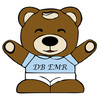DB EMR
Detailed App Info:
Application Description
DB Medical Record approach to treatment diabetes compliance involves bringing together not only all of these stakeholders. DB Medical Record links children, parents, caregivers, and physicians together through a common avatar: a toy bear. It also links children to other children with the chronic condition (e.g. diabetes)- again via a toy bear. The toy bear itself can educate and provide feedback to the child and caregivers/parents. The bear’s avatar appears is integrated into the medical record. The avatar provides animations that convey happy/sad emotions based on compliance and measurement results within the clinical record. Thus, the patient (child)/doctor interactions can thus be more engaging- providing the patient with feedback on their performance (and “stars”, rewards, etc.). The lab is looking to add other features as well such as allowing one child’s bear to interact with another child’s bear locally or remotely (via internet connection)- all while encouraging the children to stay engaged in the treatment process. Two models are being considered for implementation and testing: a competitive model whereby children compete with ach other to achieve best compliance via the interacting bears) and a co-operative model whereby bears encourage children to work together to achieve the best results together.
In our diabetes system, children are presented with a toy bear that has devices such as a glucose measuring system (and can integrate insulin pump). The children learn from the bear. Caregivers and children can be alerted and encouraged by the when it is time to “feed” the bear (via glucose measurement). This makes treatment compliance fun. Once complete, the measurements are automatically uploaded into the cloud and be downloaded into the physician medical record. An iPhone/iPad app can also automatically show results to parents/caregivers.
We have created a SMART (Substitutable Medical Applications, Reusable Technologies) app that runs on an iPad and can access these measurements and other clinical and genetic data to give the physician a full perspective on patient state. The bear-based animations (i.e. avatars) in the medical record interface that provide engaging feedback and reinforcement for patient, caregiver, and physician. This makes diabetes management fun and rewarding for the children both away from the clinic as well as during office visits.
DB Social Medical Record works by integrating several technologies. “Jerry the Bear” is a teddy bear designed by a local start-up, Sproutel Inc., to aid kids in learning about their medical issues and treatments. The project is not tied to that particular bear. In fact, toys other than bears can be used provided that BCL creates the corresponding avatars for them (as the lab has for the bear.) The lab has integrated this educational aspect with the Telecare glucose meter / pump technology to provide clinical data to hospital EMRs and clinicians. In short, this work provides kids with a “fun” way to measure glucose and take insulin. Furthermore, the application interface provides extensive and detailed live data for clinicians and patients to view. Interactive bear animation provides easily understandable positive/negative feedback to patients. Ultimately these features provide patients an engaging yet informative experience that increases their likelihood to comply with their treatment.
In our diabetes system, children are presented with a toy bear that has devices such as a glucose measuring system (and can integrate insulin pump). The children learn from the bear. Caregivers and children can be alerted and encouraged by the when it is time to “feed” the bear (via glucose measurement). This makes treatment compliance fun. Once complete, the measurements are automatically uploaded into the cloud and be downloaded into the physician medical record. An iPhone/iPad app can also automatically show results to parents/caregivers.
We have created a SMART (Substitutable Medical Applications, Reusable Technologies) app that runs on an iPad and can access these measurements and other clinical and genetic data to give the physician a full perspective on patient state. The bear-based animations (i.e. avatars) in the medical record interface that provide engaging feedback and reinforcement for patient, caregiver, and physician. This makes diabetes management fun and rewarding for the children both away from the clinic as well as during office visits.
DB Social Medical Record works by integrating several technologies. “Jerry the Bear” is a teddy bear designed by a local start-up, Sproutel Inc., to aid kids in learning about their medical issues and treatments. The project is not tied to that particular bear. In fact, toys other than bears can be used provided that BCL creates the corresponding avatars for them (as the lab has for the bear.) The lab has integrated this educational aspect with the Telecare glucose meter / pump technology to provide clinical data to hospital EMRs and clinicians. In short, this work provides kids with a “fun” way to measure glucose and take insulin. Furthermore, the application interface provides extensive and detailed live data for clinicians and patients to view. Interactive bear animation provides easily understandable positive/negative feedback to patients. Ultimately these features provide patients an engaging yet informative experience that increases their likelihood to comply with their treatment.
Requirements
Your mobile device must have at least 2.86 MB of space to download and install DB EMR app. DB EMR is available on iTunes for $0.00
If you have any problems with installation or in-app purchase, found bugs, questions, comments about this application, you can visit the official website of Harvard Medical School (cbmi) Boon Industries LLC at http://bcl.med.harvard.edu.
Copyright © Biomedical Cybernetics Laboratory, Harvard Medical School





